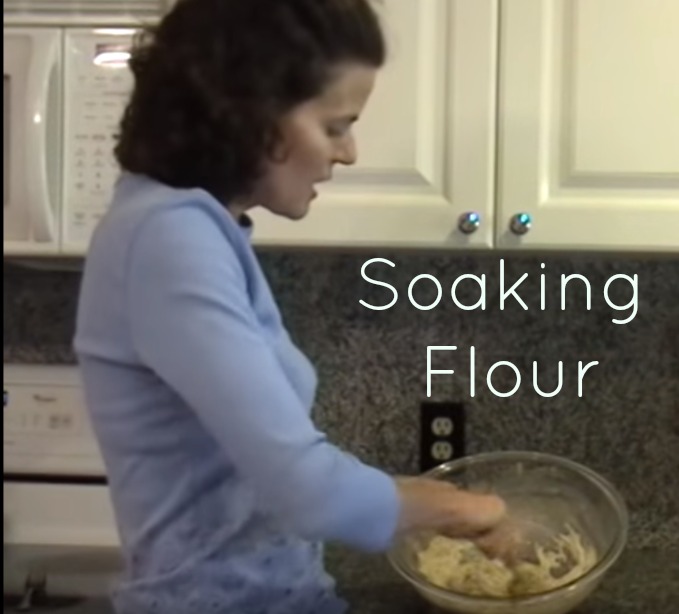Table of Contents[Hide][Show]
Soaking flour for maximum digestibility is one of the three traditional methods of grain preparation for healthy, nutritious bread as practiced by Ancestral cultures.
One of the most important baking techniques to learn when implementing a traditional diet is soaked flour. This ancestral method of grain preparation enhances digestibility and improves the metabolism of nutrients.
This technique also reduces anti-nutrients such as phytic acid in the grain flour. These substances block mineral absorption and can aggravate inflammation of the intestinal tract. Gluten-free grains also contain these anti-nutrients.
Other methods for reducing anti-nutrients in grains and improving metabolism include sour leavening (sourdough) and sprouting.
How to Soak Flour
Soaking flour is simple. Simply mix grain flour with yogurt, kefir, or clabbered milk, cover with a dishtowel, and let sit on the counter overnight. Freshly ground flour produces the best results. After the allotted soaking time, blend in the remaining ingredients and bake or cook as usual.
Non-grain based flours such as cassava and coconut flour do not need soaking. Others such as almond flour and chickpea flour are best soaked before grinding rather than after.
Dairy-Free
For those with milk allergies, substitute 1 cup of filtered water per cup of flour plus 2 TBL of lemon juice or apple cider vinegar and soak as usual for at least 8 hours or overnight.
For those with more extreme wheat sensitivities, the soaking time can be increased up to 24 hours to further breakdown gluten and other anti-nutrients.
Soaking any longer than 24 hours risks the development of mold.
Soaking Flour Technique Applies to All Grains
The principle of soaking can be applied to whole grains as well, such as your morning oatmeal. It was common to soak oats overnight before cooking back before WWII. This step was apparently even suggested on the Quaker oatmeal box!
It seems with the modern preference for speed in food preparation, this essential step has been lost. Hardly anyone under the age of 80 even remembers it anymore.
Try soaking your oatmeal the night before and see how much more filling it is after you cook and eat it the next morning.
Instead of being hungry again at 10 am, you will likely be full right through until lunch! To soak oatmeal, use 1 cup of warm filtered water per cup of oats plus 2 TBL whey, yogurt, kefir, or buttermilk. Stir together in the pot you will cook them in, cover with the lid, and leave overnight.
Cook, as usual, the next morning.
Bread Recipes Using Soaked Flour
Try this soaked bread recipe with your soaked flour. You can also try making a soaked loaf in a bread machine.
The video in the recipe tutorial below demonstrates visually the simple process of soaking flour. Try it with your next flour-based recipe!

How to Soak Flour
How to soak flour of all kinds before making the batter to improve digestibility and nutritional benefits of bread and other baked goods.
Ingredients
- 2 cups flour preferably freshly ground and organic
- 2 cups whole milk yogurt
Instructions
-
Mix flour and yogurt in a large bowl.
-
Cover with a clean dishcloth and secure with a large rubber band.
-
Leave on the counter overnight or for 8 hours.
-
Uncover, mix in remaining ingredients for whatever recipe you wish to make and bake as usual.
Recipe Video
Recipe Notes
Clabbered milk or plain kefir may be substituted for yogurt.
If there is a dairy allergy, 2 cups of water plus 2 Tbl lemon juice may be substituted. This reduces the calories to 910 for one batch.








Hey I loved the video! I’ve been soaking my flours for awhile now and I have a question. I was told that all purpose flour doesn’t need to be soaked because it contains no phytic acid. Is this true? I don’t use all purpose flour but I would still like to know. Thanks =)
Hi. Another question I had was that when you say soak it in apple cider vinegar, will any apple cider vinegar do or does it have to be the one which has the mother in it?
Thank you.
I am just learning about soaking flour. Thanks for this video, it is so helpful! My daughter and I soaked some flour overnight and then used it to make biscuits (cookies). It failed terribly! As the flour was wet and gooey, the biscuits just spread out very thin and didn’t cook well. Can you help me? Can soaked flour not be used for things like this? If not, what can I use instead and what things can you make with soaked flour?
Thanks for your help!
Hi Sarah:
Loved your instructions on soaking flour. I have several questions. I do not use wheat flour, but use grains such as millet, amaranth, buckwheat, etc. Regarding the grains that I have to grind, could I just soak these overnight, pour out the liquid that is left, and dehydrate them so I can use them when I need them? I would of course, have to grind them at that time, and use whatever recipe I have. Some non gluten breads call for garbanzo beans and I wanted to soak and dehydrate them prior to using them for flour.
What’s your opinion?
Ruth
I left about a quart of raw milk in plastic gal. out on counter 3 days! Some solidified but, most stayed very liquid. When I poured out onto cloth the white liquid flooded the bowl. I scooped out the little bit of solids and used the liquid to soak my wheat flour for pancakes. Was this OK?
I would appreciate some suggestions on why milk didn’t klabber.
You may already know this, but milk needs an acid to clabber the proteins.
I pour raw milk into a huge measuring cup and add fresh lemon juice, vinegar works too. I do this after it sits for a day or two to make it nice and sour, then add the juice and sit for another day or two. Now strain and you have cottage cheese and whey.
If you want milder cheese, add the lemon (or vinegar) in the beginning and let it sit for 1-3 days, then strain. It’s all good!
Should I soak flour when making a 5 minute artesan bread? Will it still work? Do I stll add the water according to the recipe after soaking? Can I use whey and water for the soaking? Thanks for the help.
Is it necessary to soak sprouted flour? I’m just curious if it furthers digestibility in any way.
If I am using apple cider vinegar, how much vinegar to water do I use to soak flour? Is it the same as soaking oats?
Ruth
Missina
I’ve made the recipe three times now, with the soaking beforehand and have used 1/2 a pint of milk rather than one pint. I have also given up expecting it to be a dough. Instead, I pour it into a pie dish and cook it as a batter.
It has actually ended up turning out nicer than the original recipe and it stays softer longer. It now tastes like what I imagine sourdough does.
I’ve just recently bought Nourishing Traditions and hope it also details more explicitly how to adjust recipes that have been soaked.
Can you use low pasteurized milk to make sour milk safely?